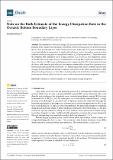Note on the Bulk Estimate of the Energy Dissipation Rate in the Oceanic Bottom Boundary Layer
Author(s)
Ruan, Xiaozhou
Downloadfluids-07-00082.pdf (1.085Mb)
Publisher with Creative Commons License
Publisher with Creative Commons License
Creative Commons Attribution
Terms of use
Metadata
Show full item recordAbstract
The dissipation of the kinetic energy (KE) associated with oceanic flows is believed to occur primarily in the oceanic bottom boundary layer (BBL), where bottom drag converts the KE from mean flows to heat loss through irreversible mixing at molecular scales. Due to the practical difficulties associated with direct observations on small-scale turbulence close to the seafloor, most up-to-date estimates on bottom drag rely on a simple bulk formula (<inline-formula><math xmlns="http://www.w3.org/1998/Math/MathML" display="inline"><semantics><mrow><msub><mi>C</mi><mi>d</mi></msub><msup><mi>U</mi><mn>3</mn></msup></mrow></semantics></math></inline-formula>) proposed by G.I. Taylor that relates the integrated BBL dissipation rate to a drag coefficient (<inline-formula><math xmlns="http://www.w3.org/1998/Math/MathML" display="inline"><semantics><msub><mi>C</mi><mi>d</mi></msub></semantics></math></inline-formula>) as well as a flow magnitude outside of the BBL (<i>U</i>). Using output from several turbulence-resolving direct numerical simulations, it is shown that the true BBL-integrated dissipation rate is approximately 90% of that estimated using the classic bulk formula, applied here to the simplest scenario where a mean flow is present over a flat and hydrodynamically smooth bottom. It is further argued that Taylor’s formula only provides an upper bound estimate and should be applied with caution in the future quantification of BBL dissipation; the performance of the bulk formula depends on the distribution of velocity and shear stress near the bottom, which, in the real ocean, could be disrupted by bottom roughness.
Date issued
2022-02-18Department
Massachusetts Institute of Technology. Department of Earth, Atmospheric, and Planetary SciencesPublisher
Multidisciplinary Digital Publishing Institute
Citation
Fluids 7 (2): 82 (2022)
Version: Final published version